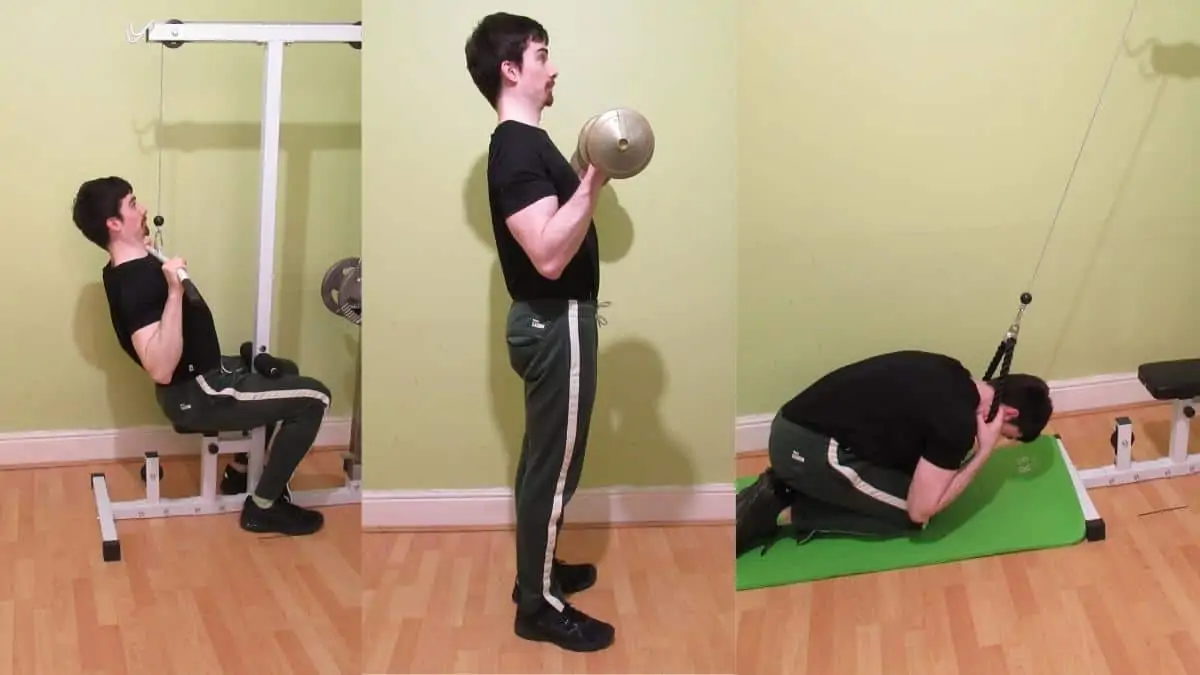Understanding the bicep science and that of your back and abs can help you to maximize your results. For example, knowing that the lats primarily perform shoulder extension and adduction leads you to conclude that vertical pulling exercises are better than horizontal rows for lat development.
This 9-exercise back biceps abs workout trains your muscles from different angles and with various rep ranges so that you can achieve the best possible results.
Rest 2-3 minutes between sets of compound movements (the first three exercises) and 1-2 minutes between sets of isolation exercises. Leave 1-2 reps in reserve on each set.
Check out our other full bicep workouts for more training ideas, or keep reading for a full back bis and abs routine.
1. Neutral-grip pulldown — 3-5 sets of 6-10 reps
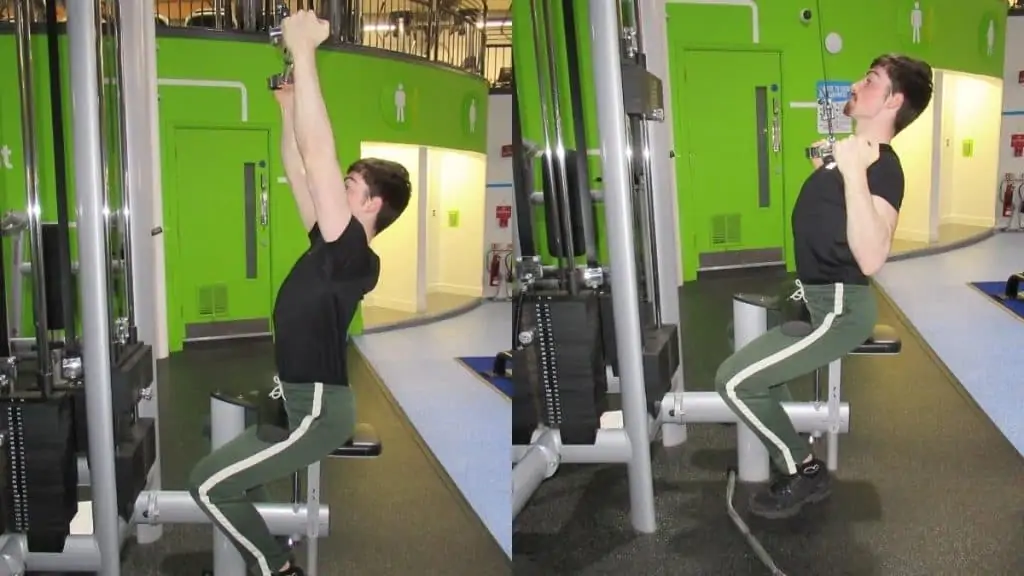
Neutral grip pulldowns hit the bulk of the lats to improve the overall width and size of your back.
Hence, they’re an excellent addition to any muscle-building back and bicep workout.
This lat width, in turn, helps you to develop a more aesthetic physique by building a better v-taper.
Pulldowns also require less core stability than their bodyweight counterpart, pull-ups, which means that you can focus purely on working your lats rather than on balancing your body.
So if you’re training for maximum hypertrophy, then it’s a brilliant idea to start your back biceps and abs workout with a machine-based movement like neutral pulldowns.
- Attach a neutral pulldown bar to the pulley.
- Sit on the pulldown station and grab the bar with a neutral/hammer grip.
- Arch your upper back slightly and look straight ahead.
- Pull the bar toward your chest by squeezing your lats (drive your elbows down and slightly inward).
- Keep pulling the bar until it touches your mid-chest or until your lats are maximally contracted.
- Hold the contraction for a split second.
- Release the bar in a controlled manner until your elbows are almost (but not quite) locked out.
2. Wide-grip pulldown — 3-5 sets of 8-12 reps
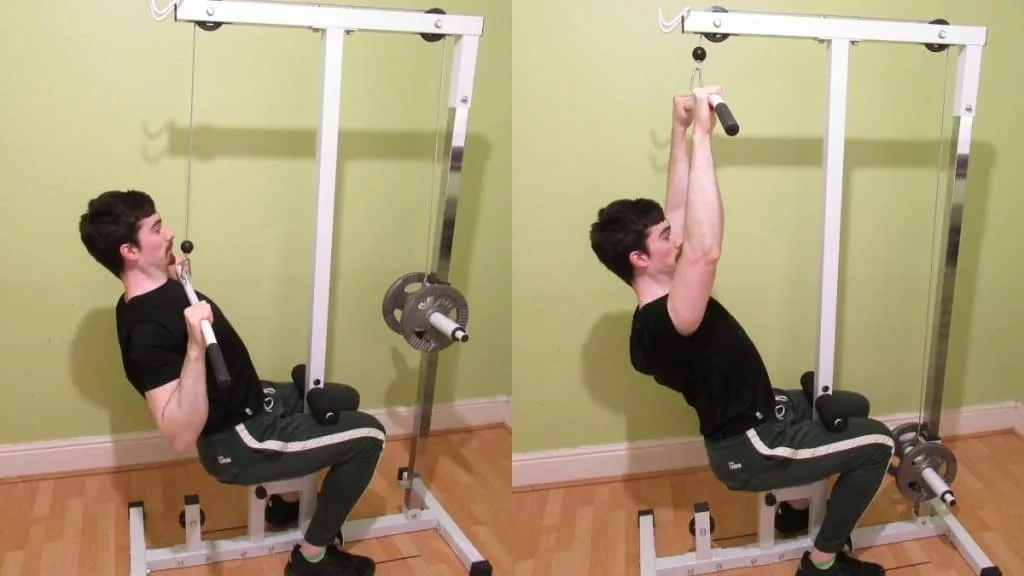
Wide grip pulldowns train shoulder adduction and, as such, are an excellent exercise for working the lower muscle fibers of the latissimus dorsi.
The trick is to use a comfortably wide grip rather than an excessively wide grip.
Sounds easy enough, right?
Well, you’d be surprised at just how many lifters sabotage their back development (and their shoulders) by using extreme grip widths during pulldowns.
So, don’t grip the bar at its very ends; grab it a few inches outside shoulder width instead.
This way, you’ll be able to get a more extensive range of motion for your lats, lift heavier weights, and avoid straining your rotator cuffs.
- Grab the bar with a wide overhand grip.
- Sit on the seat and tuck your knees under the leg pad.
- Arch your upper back slightly.
- Pull the bar to your mid-chest by driving your elbows down and into your sides.
- Keep pulling the bar until it touches your chest.
- Hold the contraction for a second.
- Release the bar under control for a full lat stretch.
3. Cable row — 3-5 sets of 10-15 reps
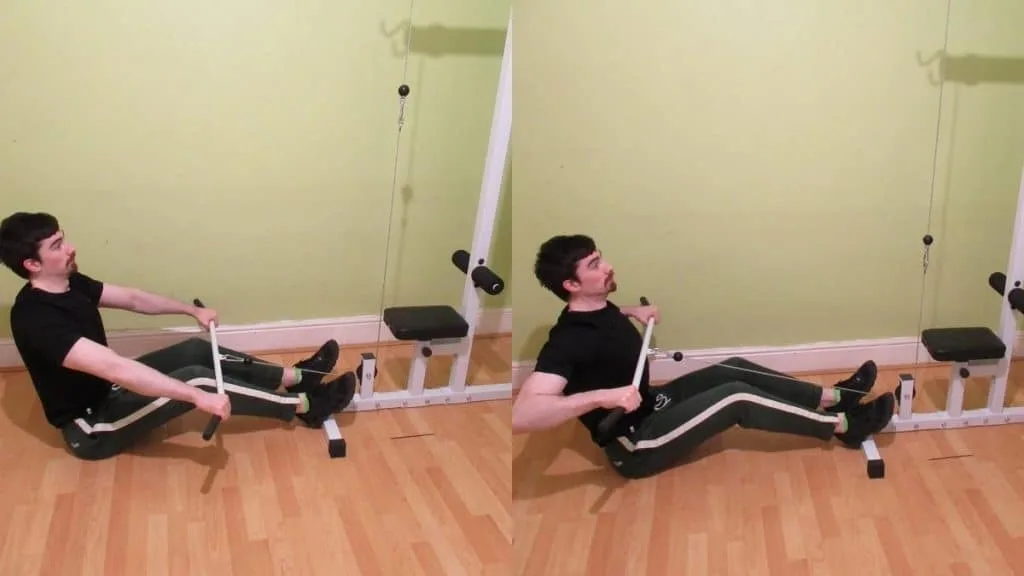
There are a lot of cable exercises in this routine; and for good reason.
Unlike their free weight equivalents, cable rows and pulldowns make your lats and traps work overtime during every part of the lifting motion. In other words, you can’t just rest at the bottom of your reps because the cable pulley is constantly exerting some kind of force on your back muscles.
The beauty of cable rows is that they’re completely customizable to your strengths and weaknesses.
For example, to increase your back thickness by building your traps, you can grab the bar with a wide-overhand grip and row it higher up on your abs or to your lower chest.
Conversely, to accentuate your lat width, you’ll want to use a d-handle attachment, grab it with a close-neutral grip (or grab a straight bar with a close-underhand grip) and row it into your lower abs.
You can also perform a resistance band back and bicep workout if you don’t have access to cables or can’t get to the gym.
- Connect your desired attachment to the seated row station.
- Sit on the seat with your torso straight and abs tight.
- Grab the attachment and row it toward your abs by squeezing your back muscles (as if you’re pinching a ball between your shoulder blades).
- Row the bar all the way to your torso and then contract your lats and traps as hard as you can.
- Release the contraction and let the bar travel back to the starting position by way of a big lat/trap stretch.
4. Machine rear delt fly — 3-4 sets of 12-15 reps
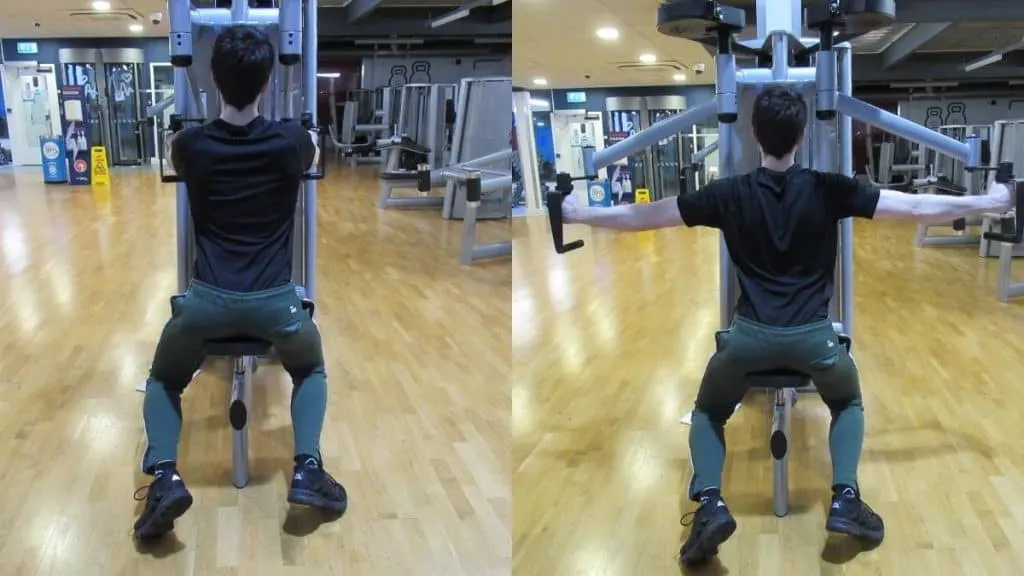
While you can train your rear delts with your shoulders instead, it often makes sense to work them with your back because rows and the like already work the rear delts to a large extent.
So consider this exercise optional. You can certainly do it in a back bicep shoulder workout as well.
Your best bet is to use cables, or, in this instance, the chest fly machine is a reverse position because free weights provide very inconsistent tension on rear delt flys.
- Move the handles on a chest fly machine all the way back.
- Sit on the machine in a reverse position with your chest against the back pad.
- Grab the handles and perform a reverse fly motion by moving the handles out to the sides.
- Keep going until you feel a strong contraction in your rear delts.
- Reverse the movement and return the handles back to their original position.
5. Incline alternating dumbbell curl — 3-4 sets of 6-8 reps
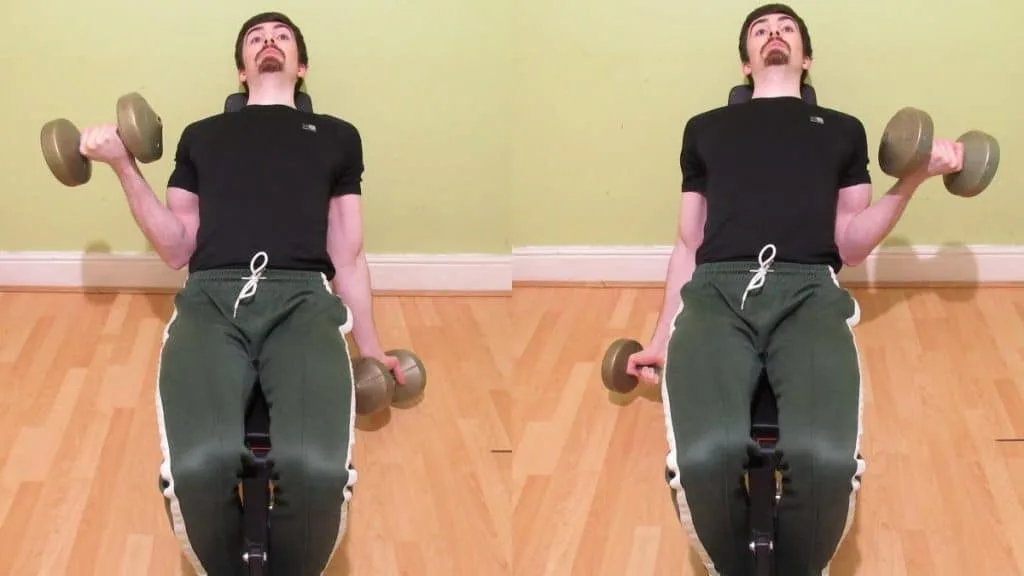
Incline alt dumbbell curls are an incredible bicep-building exercise for a few reasons.
First off, incline curls train the long (outer) head of the biceps, which is a weak point for many lifters. So by improving this head, you can actually make your biceps look wider, especially when viewed from the front (unflexed) and from the side.
Also, by doing your curls in an alternating fashion, you’ll naturally be able to perform extra reps on each set (because each bicep gets a short rest while the opposite arm is curling) and thereby accumulate more training volume—getting enough of which is critical for hypertrophy.
- Set the backrest of an adjustable bench to a 60-degree angle.
- Grab a pair of dumbbells with an underhand grip.
- Sit on the bench and lie against the pad.
- Let the weights hang over either side of the bench.
- Curl the dumbbells toward your shoulders while keeping your elbows still.
- Keep lifting until the undersides of your forearms push right up against your biceps.
- Hold the contraction for a moment.
- Lower the dumbbells in a controlled manner until your elbows reach full extension.
6. EZ cable curl — 3-4 sets of 8-12 reps
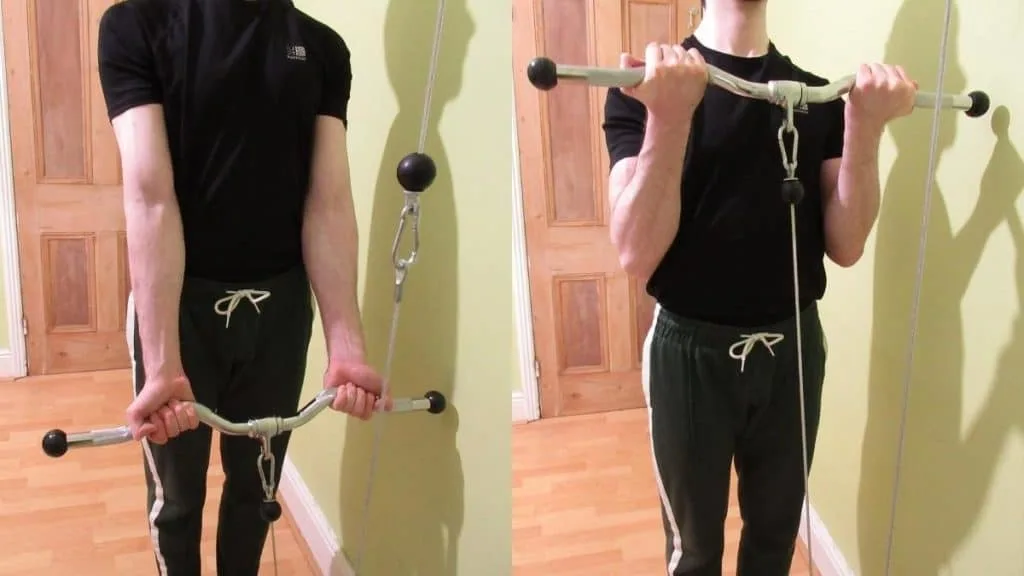
EZ cable curls are the next movement in this back biceps abs workout and one which really pumps up your arms and keeps your wrists out of trouble.
This is because cables don’t give your biceps any kind of rest until the set is over (with free weight curls, on the other hand, you can just rest at the bottom of each rep to lessen the burn). As such, the lactic acid doesn’t have a chance to escape, and so for your hard work in resisting the bicep burn, you get rewarded with a powerful muscle pump.
EZ attachments also put less pressure on your wrists and forearm flexors than straight bars because they don’t force your lower arms into full supination. Instead, they have semi-supinated grips that make the bar easier and more comfortable to hold onto, which means that you can keep focused on the task at hand.
- Connect an EZ attachment to a low pulley.
- Grab the bar with an underhand grip.
- Curl the bar toward your chest while keeping your elbows and shoulders stationary.
- Keep curling until your forearms and biceps make forceful contact.
- Hold the peak contraction for a moment.
- Lower the bar in a controlled manner until your arms are locked out.
7. Reverse spider curl — 3-4 sets of 12-15 reps
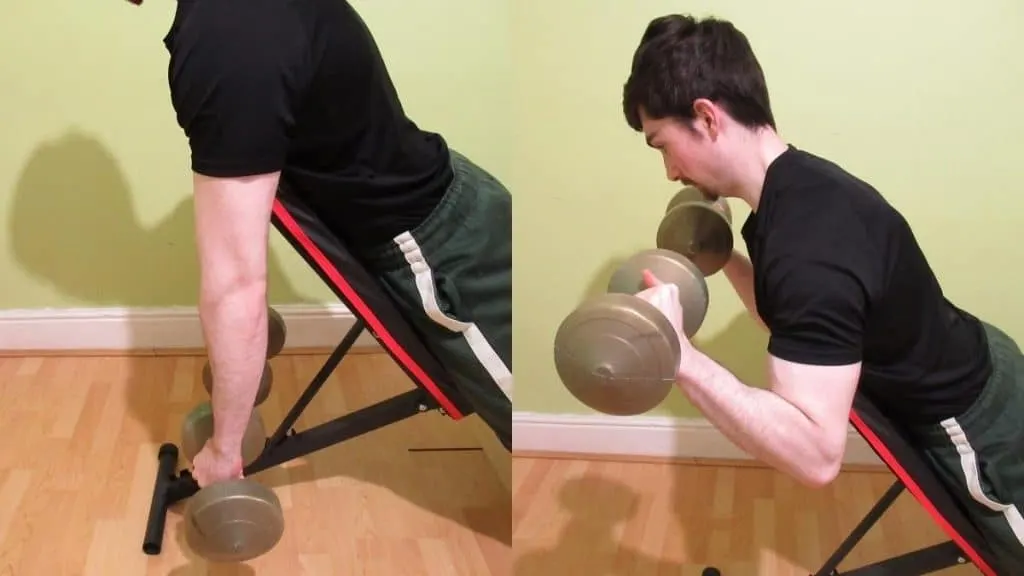
No back biceps and abs workout is complete without an exercise for the brachioradialis and brachialis, two arm muscles with lots of growth potential.
The easiest way to train these two powerhouses is to place your biceps at a mechanical disadvantage, which is to say by curling with an overhand grip.
Performing a spider curl with a reverse grip is particularly effective because you can’t swing the weights up when your torso is braced against the bench or when your feet are planted firmly on the floor.
- Set the backrest of an adjustable bench to 60 degrees.
- Grab a relatively light pair of dumbbells with a thumbless overhand grip.
- Sit on the bench in a reverse position with your torso pressed against the pad.
- Let your arms hang forward so that your elbows are extended.
- Curl the weights toward your shoulders until the tops of your forearms press right up against your biceps.
- Hold the peak contraction for a moment.
- Lower the dumbbells under control until your arms are locked out.
8. Hanging leg raise — 3-4 sets of 12-15 reps
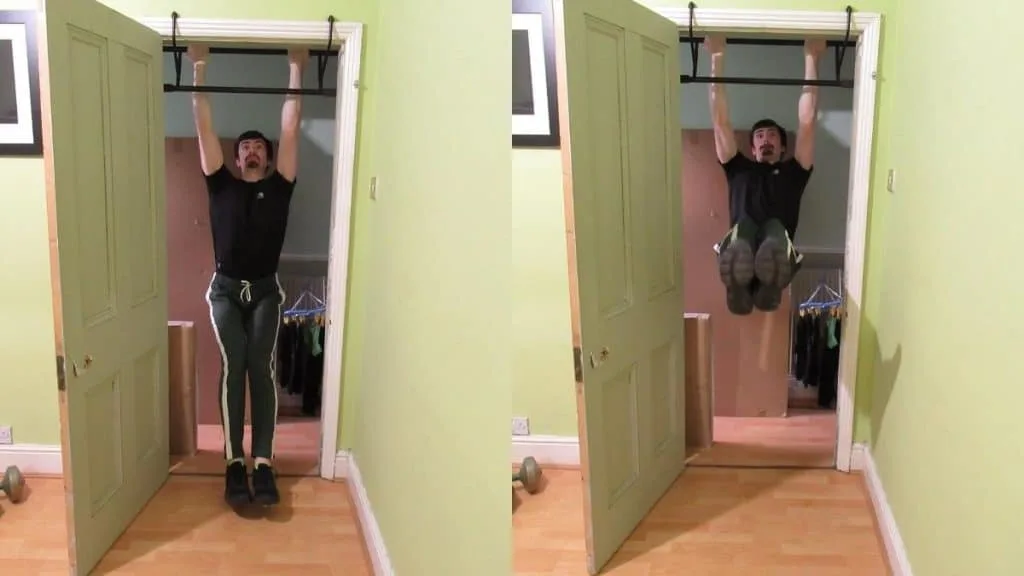
The abdominal section of this back biceps and abs workout consists of just two exercises; one that emphasizes the lower abs (hanging leg raises) and one that targets more of the upper abs.
While you can certainly do more movements if you want to bring up your abs, your core already gets a lot of work during compound exercises like squats and overhead presses.
So use your best judgment and add or subtract exercises and sets as needed (some lifters have great abs—blocky ones, too—without any direct training).
- Hold onto a pull-up bar with a shoulder-width grip.
- Bend your knees slightly and put your legs and feet together.
- Raise your knees toward your stomach while letting your hips curl up/forward (this massively intensifies the contraction).
- Keep raising your legs until you feel a strong abdominal contraction.
- Lower your legs slowly and repeat.
9. Cable crunch — 3-4 sets of 12-15 reps

Cable crunches are an old-school ab-building exercise that really makes your core burn.
They’re also a brilliant exercise for gaining strength consistently because cable stacks typically ascend in very manageable increments.
- Connect a rope attachment to a high pulley.
- Grab the rope, hold it in front of your head, and assume a tall kneeling position in front of the machine.
- Lock your hips in place and then flex forward at the spine to contract your abs.
- Squeeze your abs as hard as you can, and then let your spine extend until your torso is back in an upright position.
See also: Back and bicep workout for females
In conclusion
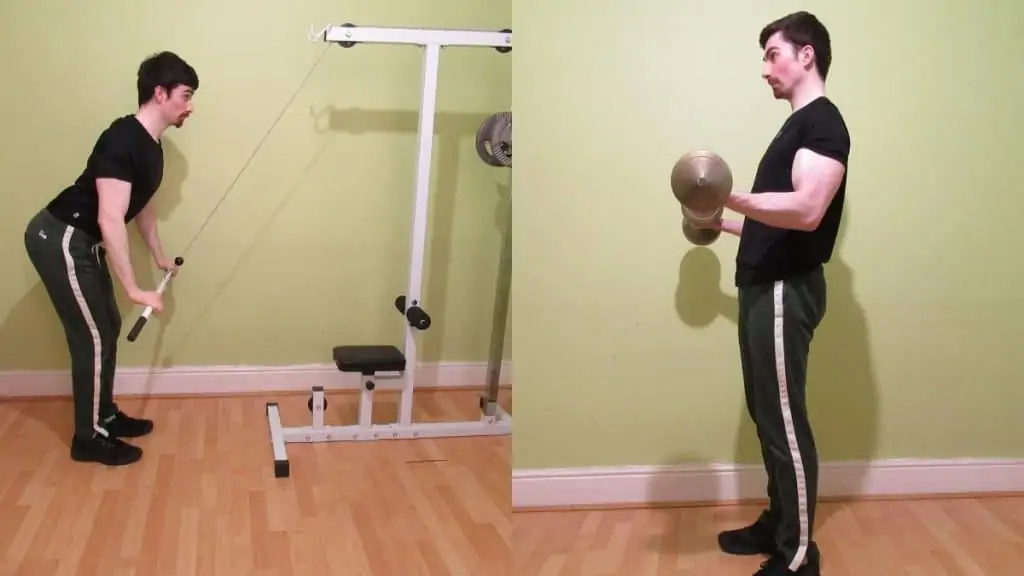
This hypertrophy-focused back biceps abs workout will improve your v-taper, strengthen your core, and accelerate your arm growth. Perform the routine once per week if you’re a novice lifter or twice weekly if you’re advanced. Intermediates can choose either frequency depending on their physique goals and commitment level.
The order of each exercise in the routine has been well thought out. But you can also change the sequence depending on your individual weak points. For example, if you already have wide lats but still lack that upper back thickness, then you should start your workout with rows and perhaps even consider including a second row variation later on in the session.
We included two pulldowns and one rowing movement because pulldowns already work the traps well, so doing more than one row variation can often be redundant and lead to the accumulation of junk volume.

